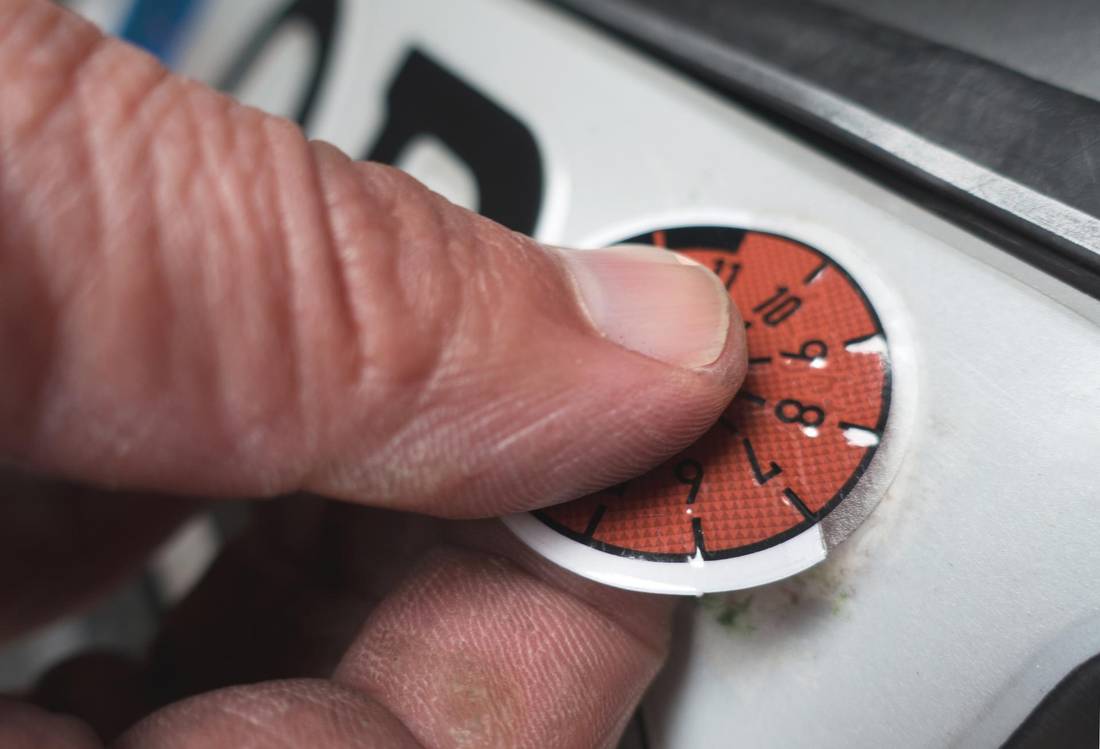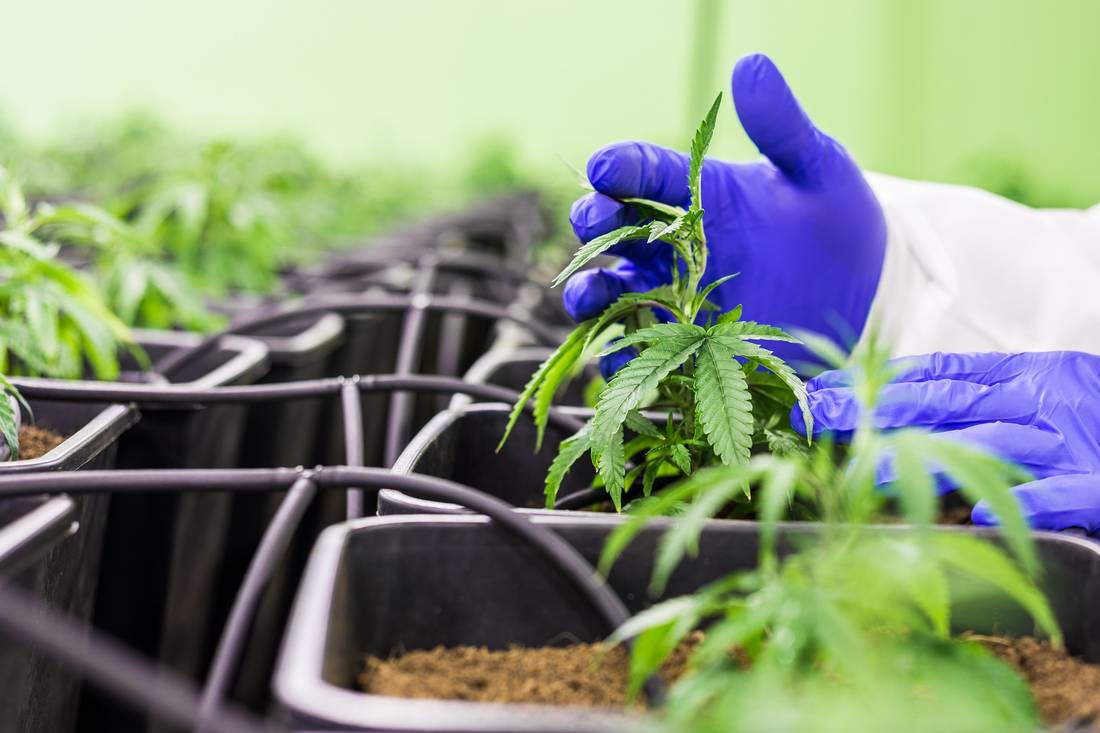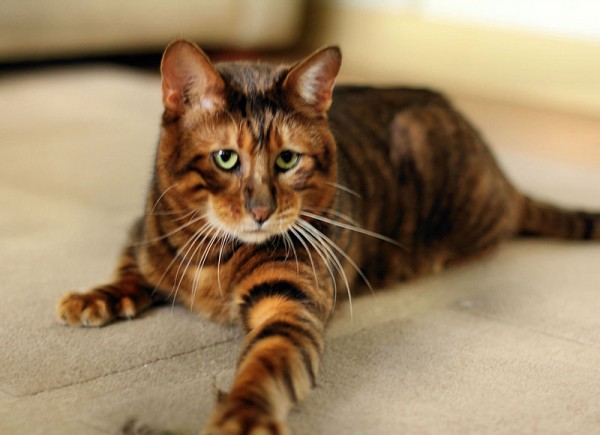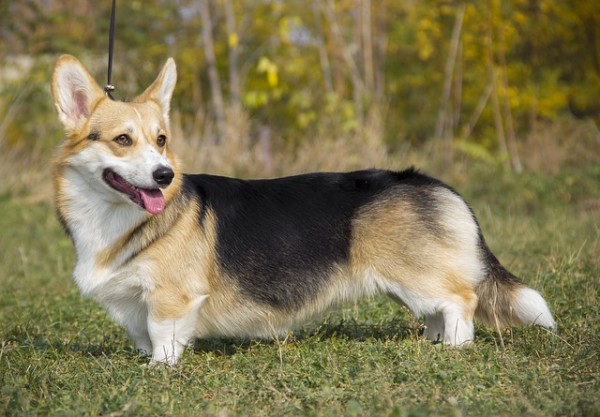Many palm species can be found in the tropics or subtropics. The European dwarf palm is a plant that occurs in the Mediterranean in the wild and belongs to the Mediterranean plants. This small palm species can be grown in the garden in the Netherlands and Belgium because the plant can tolerate temperatures below freezing point in winter. That makes the plant a very popular palm tree in the Netherlands and Belgium for the terrace and in the garden. The plant has a Mediterranean appearance and provides a holiday feeling.
- The European dwarf palm
- Other palm species in the Netherlands and Belgium
- Good winter protection
- Description of the European dwarf palm or Chamaerops humilis
- The build of the European dwarf palm or Chamaerops humilis
- The carrots
- The leaf
- The tribe
- Bloom
- Reproduction
- Grooming
The European dwarf palm
The European dwarf palm (Chamaerops humilis) is a genus of the palm family (Arecaceae or Palmae). The palm family has nearly four thousand species, most of which are palm species found in the tropics or subtropics.
Other palm species in the Netherlands and Belgium
Palm species that belong to the palm family and also grow well in the Netherlands and Belgium, include the:
- Trachycarpus fortunei (Chinese hemp palm, windmill palm or Chusan palm). Fairly hardy but drops its leaves in moderate frost (-15 to -20 degrees);
- Nannorrhops ritchiana. Can withstand severe frost in the winter (-15 degrees);
- Jubaea chilensis. Can withstand severe frost down to -12 degrees Celsius;
- Phoenix canariensis. Can tolerate frost down to -5 degrees;
- Cretan date palm (Phoenix theophrasti). Can survive temperatures down to -6 degrees of frost;
- Areca palm. Known as Dypsis lutescens or golden palm. The golden palm cannot withstand frost and must go indoors in the winter;
- Washingtonia or Mexican fan palm. Frost resistant to -4 degrees.
Good winter protection
Many palms in the garden can tolerate frost, but in the Netherlands and Belgium temperatures can drop to -20 degrees or even more. The palms therefore need winter protection in moderate to severe frost by:
- cover the roots with leaves or wood chips;
- to bind the crown of the palm together and to wrap it with cloth, burlap or reed mats. Straw or leaves can be placed in the cloths or mats for extra insulation.
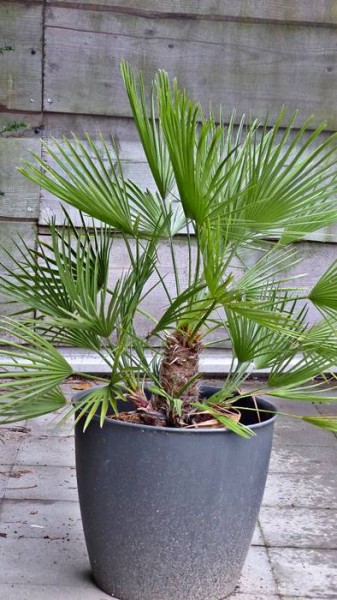
Description of the European dwarf palm or Chamaerops humilis
The European dwarf palm is a palm species that originated in Europe. The palm is also found in Algeria, Tunisia, Libya, Egypt and Turkey. The plant is native to the Mediterranean and is a Mediterranean plant. The palm can withstand heat well and can tolerate frost to about -10 degrees Celsius in winter. This fact makes it an ideal plant to create a piece of Mediterranean feeling on your own terrace or in the garden in the Netherlands and Belgium. A dwarf palm in a permanent spot in the garden is quite possible, if the plant can stand in the sun and is protected from severe to very severe frost.
The leaves of the dwarf palm resemble a large fan that you use to give your coolness. The European dwarf palm is therefore a fan palm. A fan palm has palmate lobed leaves. The dwarf palm grows on many soil types and especially when it is warm the palm grows quickly. The dwarf palm grows with new shoots at the end of the trunk. The European dwarf palm forms several trunks at the bottom of the trunk as it grows older, which is why the dwarf palm grows so beautifully full and compact. The dwarf palm is small compared to other palm species, but an adult dwarf palm can still reach seven meters high and nine meters wide.
The build of the European dwarf palm or Chamaerops humilis
The European dwarf palm consists of three parts:
- The carrots;
- The leaf;
- The tribe.
The carrots
The roots of the Chamaerops humilis grow straight down in the ground. In a closed bottom of a tub or flower pot, the roots gather en masse at the bottom.
 Lobed leaf.
Lobed leaf. Young leaf, folded together.
Young leaf, folded together.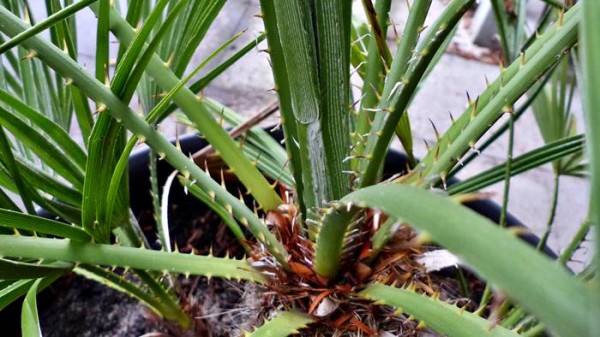 Growth point of the trunk.
Growth point of the trunk.The leaf
The young leaf grows at the top of the trunk of the palm and one leaf is made up of numerous fairly narrow, blue-green leaves. The narrow leaves lie on top of and against each other and slowly open into a fan-shaped leaf. The fibrous leaf has deep incisions up to half (lobed) and the leaves can reach a diameter of up to one meter. The many veins (fifteen or more) of the leaf run from the petiole to the tip of the leaf and give a structure with an elevation with each vein. The structure is reminiscent of a harmonica door (folding door). The petioles are no longer than 50 centimeters and have sharp spines on the sides that can grow up to 30 to 90 centimeters long. The fan-shaped leaves have a color from grass green to silvery green.
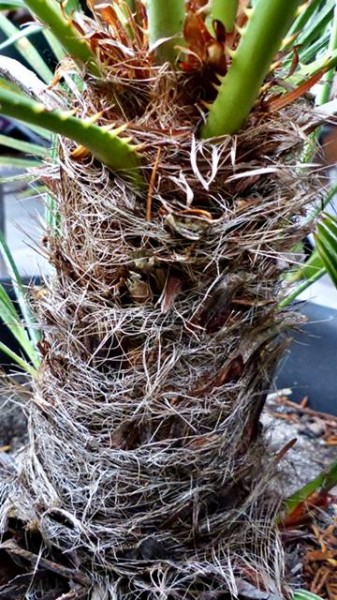 The tribe.
The tribe.The tribe
The European dwarf palm or Chamaerops has a false trunk and no stem. The false stem consists of leaf bases of dead leaves. The trunk has no growth rings like a tree and no bark. The European dwarf palm develops one main stem with one growing point. The trunk has a natural protection of fibrous threads of the dead leaves. They give the trunk a hairy appearance. A young palm can only grow in height after a certain width has been reached. New shoots are formed next to the underside of the main trunk. The result is a nice compact shape.
Bloom
The Chamaerops humilis is generally dioecious and needs a female and male palm to achieve seed production. Very rarely is the palm monoecious, which means that both male and female flowers appear on the same plant. The Chamaerops Humilis produces flowers in the flower sheaths, at the top of the trunk, from the age of 6 years. From mid-April to mid-June, numerous small, yellow male or female flowers emerge from the flower sheaths. The female flowers are arranged in short clusters between the petioles and the male flowers have longer and dense clusters. The male flowers give off a wonderful scent.
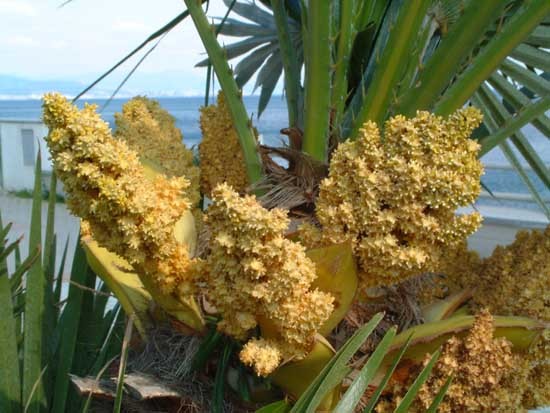 Source: Angelofer@aliceposta.it, Wikimedia Commons (CC BY-SA-2.5)
Source: Angelofer@aliceposta.it, Wikimedia Commons (CC BY-SA-2.5)
Reproduction
Palm propagation occurs by seed formation or by the tearing of the shoots that emerge next to the main trunk. The female flowers are pollinated by the wind and will form seeds. The seeds are oval to spherical, one to two centimeters in size and orange, brown, red or black in color. The seeds germinate easily (after about six weeks) when they reach the ground.
Grooming
Repotting
A dwarf palm in a pot or tub needs sufficient depth. Repotting is necessary every about five years in the spring. The new pot only needs to be slightly larger because in a very large pot the palm roots cannot get used to quickly enough. However, it is possible to put the plant back in the same pot, after cutting away about 1/5 of the roots. Cut away the excess carrots in slices.
Cow dung
When repotting the palm, add cow manure granules to the potting soil. A handful of cow manure pellets every month ensure good root development. Give the plant another potassium-rich fertilizer in the garden or on the patio in September. The content of potassium salts in the plant juices improves winter hardiness.
Pruning
In spring, the leaves that block the light from other leaves can be pruned. The older leaves that are completely brown can always be pruned. These are usually the lower leaves. Watch out for the sharp spines on the petiole.


